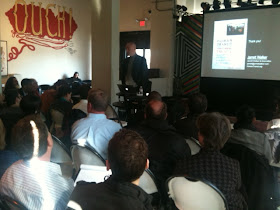The Human Transit blog has been highlighted as a link in the EnvisionBaltimore blog roll since its inception, because Jarrett Walker's innovative, yet common sense approach to designing what we've been commonly referring to as "popular transit systems," is just the kind of thinking that could have a transformative effect on the transit experience in Baltimore. His ideas also reinforce many of the key concepts that have been promoted through EnvisionBaltimore, particularly since the 20 Minute Neighborhood workshop held at the American Visionary Art Museum in April, 2011.
While I won't provide a full summary Jarrett's lecture, here are some of the key takeaways:
 |
| Jarrett Walker speaking at Metro Gallery in Station North |
Use optimal stop spacing. Transit service can become attractive for greater numbers of people if the stop spacing is increased from a typical "stop-every-block" configuration. This may require a somewhat longer, but still reasonable walk to the transit stop, but allows for more frequent service, shorter waits, and quicker journeys.
Service frequency matters more than speed. Sometimes, the biggest deterrent to using conventional transit is excessive wait time, particularly for buses. Jarrett pointed out that the wait can often be longer than the actual trip itself. A network of higher frequency routes in key corridors where there is density and destinations can result in dramatic growth in ridership.
Make use of the urban grid to create a true network. It's usually better to have a grid of high frequency, direct lines that requires someone to transfer from a north-south line to an east-west line (or vice versa) to get where they are going, rather than low frequency, meandering routes that attempt to connect destinations without transfers. Similarly, Jarrett also commented that routes that these type of meandering routes are typically not integrated with other routes and make it difficult to create a genuine network. He called this "symbolic transit," designed to serve a specialized purpose or market. While he did not make any judgments about Baltimore, I couldn't help but thinking at that moment that nearly all of Baltimore's transit routes (bus and rail) consists of this type of symbolic transit that do not function together as a system nor appeal to a wide demographic.
What's beneath the floor of the transit vehicle really doesn't matter (in many cases). Jarrett placed considerable emphasis on the idea that well designed bus networks, especially those operating in dedicated lanes can often perform just as well or better than rail. However, he did concede that streetcars or other rail technologies are most appropriate when high capacity is needed that go beyond what buses can provide. That said, there was some unchallenged difference of opinion among some streetcar boosters in the audience who would undoubtedly argue that there are factors beyond operating characteristics that favor streetcars for certain applications. This is particularly true of promoting economic development as a recent study about bringing back streetcars to the nation's capital attests.
Transit vehicles should serve as an extension of the pedestrian realm. At the end of his presentation, Jarrett showed an artists rendering of a sleek bus pulled up to a stop on a vibrant street. The bus had very large, clear windows, door, and even roof, and also had a low floor even with the sidewalk. Jarrett pointed out that buses or trams should feel like an extension of the sidewalk rather than climbing into a box. The rider should feel connected to the streetscape and continue to experience the city while on transit. During his talk he also reference the excellent book, My Kind of Transit, to reinforce this point, and to emphasize the importance of transit vehicles that feel open and pleasant, rather than havng dark tinted windows or advertising wraps.
Human Transit is available in hardcover or paperback and can ordered by following this link.
Note: for those who missed Jarrett's talk in Baltimore and want to see him at one of the DC venues he is speaking at on February 9th, I noticed that unfortunately both are sold out unless you previously registered. I am in contact with Jarrett and will alert the EnvisionBaltimore community should he return to our region.

These are great points, especially the points on stop spacing and service frequency! Did Jarrett discuss any ways to minimize "bus bunching?" Many bus routes that have fair service frequencies *on paper* turn out to have awful frequencies in reality due to this all-too-common problem. (For example, a 20 minute headway will turn into a 50 minute headway, after which you'll get two or three buses.)
ReplyDelete